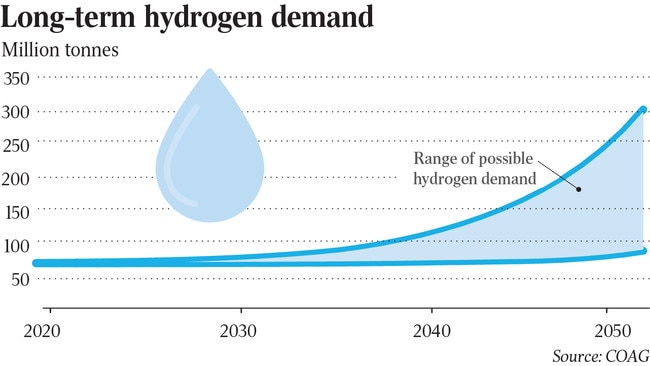Industry calls for $19bn Net Zero fund to pump up hydrogen
Australian hydrogen developers want the Morrison government to create a $19bn Net Zero fund to kickstart use of the fuel in heavy industries.

Business
Don't miss out on the headlines from Business. Followed categories will be added to My News.
Australia’s biggest hydrogen developers have called on the Morrison government to create a $19bn Net Zero fund, aimed at slashing emissions and speeding up the fuel’s rollout to the steel and heavy transport industries and in the nation’s gas sector by 2030.
With business leaders calling on Scott Morrison to commit to net-zero emissions by 2050 and adopt more ambitious 2030 targets, the industry wants the big commitment from Canberra to ensure business can become a global hydrogen player by 2030 and a top-three exporter of the fuel to Asian markets.
The fund would be managed by a newly established Net Zero Authority, covering research through to commercialisation, grants and finance and ensuring the right policy settings are in place.
Some of the country’s biggest investors and developers – including ANZ, NAB, Woodside Petroleum, Origin Energy, Wesfarmers and Fortescue Metals Group – are members of the Australian Hydrogen Council. Its blueprint calls for $10bn in seed funding and a top-up of $1bn annually through to the end of this decade, to be allocated to business through grants and loans.
It wants the Australian government to set a goal of 10 per cent hydrogen in the gas network by 2030 and targeting sectors that face challenges to cut emissions, such as steel and aluminium.
The Net Zero Authority could fold in both the Australian Renewable Energy Agency and the nation’s green bank, the Clean Energy Finance Corporation, according to the council.
“It will be important to consider ARENA and CEFC in the design, with a view to co-ordinating or integrating their operations,” Australian Hydrogen Council chief executive Dr Fiona Simon said. “The billions of dollars of future gross domestic product envisioned in the National Hydrogen Strategy will only be realised with a significant down-payment. The Australian government has, and will have, no choice. Doing nothing is not a valid option.”

The Morrison government this month announced plans for nearly $500m in new grants to accelerate Australia’s clean hydrogen industry, with funding prioritised for regional areas shifting their economies away from fossil fuel jobs, taking total government spending to $1.2bn. It first developed a national strategy to turbocharge the industry two years ago and plans to develop a new export industry responsible for 8000 jobs and $11bn of extra income by 2050.
The Australian Hydrogen Council said a grander vision was required, with support like the incentives that helped kickstart Australia’s world-leading renewable energy industry in the last decade.
“The hydrogen industry is not yet commercial and considerable investment is required,” the council says in its white paper, to be released on Monday. “It is likely that capital investments to produce hydrogen alone could run to tens of billions of dollars. Until the industry has reached commercial scale, grant funding is essential. Public investment will unlock several times its value from the private sector.”
It wants the Australian government to prioritise project funding to increase hydrogen demand in industries such as steel, aluminium and heavy transport fleets.
Andrew Forrest’s upstart green energy arm has long-term plans to produce 50 million tonnes of renewable clean hydrogen a year, equivalent to the output of some of the world’s largest oil and gas companies, while Origin and Woodside have multiple projects in the pipeline.
“If we can close the economic gap – and technology and knowledge gaps in some cases – for applications like ammonia production and heavy transport, we start to see the new hydrogen domestic industry take shape. Further, if we can drive large sources of new demand, which could be production of steel, ammonia and other chemicals for local and particularly export markets, as well as blending into natural gas networks, we will start to see scale and reduced costs,” the report says.

Hydrogen should also be blended into the natural gas system up to 10 per cent volume, lowering carbon emissions from homes and businesses reliant on gas, the report says.
A huge array of projects are in the pipeline across Australia as companies and investors look to capitalise on ample renewable resources to develop an industry that has become a key plank of the Morrison government’s technology-led solution to reach net zero emissions. It follows a warning by Treasurer Josh Frydenberg that businesses, home owners and governments could face higher borrowing costs if Australia is locked out of foreign capital markets because of “false” assumptions that the nation’s transition to a low-emissions future is moving too slowly.
“Investors are increasingly recognising that they have both an ethical and fiduciary duty to play an active role in transitioning to a decarbonised economy,” the Australian Hydrogen Council said. “The global financial system is already valuing the risk. There may be different views on when and how fossil fuels will demonstrably decline; however, markets are responding now.”
Fortescue chairman and iron ore billionaire Andrew Forrest teamed up with former prime minister Malcolm Turnbull on Friday to front a new global body promoting green hydrogen, which involves tapping renewable energy sources to obtain hydrogen from water. The fuel can then be transported as ammonia.
The Australian Renewable Energy Agency has been given an expanded brief to invest in hydrogen but it forecasts production at commercial scale may be a decade away.
“It appears that we need to have locked down a great deal within the next year or so if we are to achieve objectives such as the National Hydrogen Strategy’s ‘Australia as a top three exporter to Asian markets by 2030’ or getting hydrogen to less than $2/kg by then,” the white paper states. “Windows of opportunity need to be aligned as far as possible if we are to get to scale and do so competitively. This means planning and co-optimising different assets, and timing needs to address a range of different markets.”
More Coverage
Originally published as Industry calls for $19bn Net Zero fund to pump up hydrogen
Read related topics:Climate Change





